Invasive Species: Hemerocallis fulva, Orange Daylily
Orange daylily is a popular ornamental that has escaped to invade natural and disturbed areas throughout the United States. Plants are 2 to 4 ft. (0.6 to 1.2 m) tall with round stems. Leaves are grass-like, bright-green, 1 to 3 ft. (0.3 to 1 m) long and curve toward the ground. Flowers develop in the summer and are large, showy, and orange in color. Flowers occur in clusters of five to nine at the apex of the stalk. Flowers in a cluster open one at a time and only for one day each. Flowers may have spots or stripes. Many cultivars of daylily now exist in a wide variety of sizes and flower colors. Orange daylily infestations often occur adjacent to plantings or at old homesites. Areas invaded include meadows, forests, floodplains, ditches, and forest edges. Once established, the thick tubers make control difficult. Orange daylily is native to Europe and was introduced into the United States in the late 19th century as an ornamental.
What are invasive species and why should we be concerned about them?
Taxonomy: Scientific and Common Names for This Species
Liliales > Liliaceae > Hemerocallis fulva (L.) L.
Synonym(s): tawny daylily, common daylily
Hemerocallis fulva – USDA PLANTS Profile
Distribution Maps
Orange daylily – The reported distribution of this invasive species across the United States (Source: Invasive Plant Atlas of the United States)
Up-to-the-minute distribution maps and why they are important.
Reporting This Invasive Species
What is the best way and place to report the occurence of an invasive species?
How to report an invasive species sighting to EDDMapS – Early Detection & Distribution Mapping System
EDDMapS – Report an invasive species to EDDMapS.
Cooperative Extension Offices – Find your local Cooperative Extension office on this map provided by USDA.
How to Identify
This invasive species can be identified by looking for the characteristics described in the paragraphs that follow.
Plant
Plants are 2 to 4 ft. (0.6 to 1.2 m) tall with round stems.
 |
 |
| Britt Slattery, US Fish and Wildlife Service, bugwood.org | Ohio State Weed Lab Archive, The Ohio State University, bugwood.org |
Foliage
Leaves are grass-like, bright-green, 1 to 3 ft. (0.3 to 1 m) long and curve toward the ground.
 |
 |
| Ohio State Weed Lab Archive, The Ohio State University, bugwood.org | Theodore Webster, USDA Agricultural Research Service, bugwood.org |
Flower
Flowers develop in the summer and are large, showy, and orange in color. Flowers occur in clusters of five to nine at the apex of the stalk. Flowers in a cluster open one at a time and only for one day each. Flowers may have spots or stripes.
 |
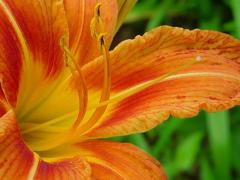 |
| Dan Tenaglia, Missouriplants.com, bugwood.org | Dan Tenaglia, Missouriplants.com, bugwood.org |
Fruit
 |
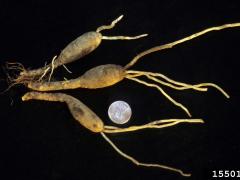 |
| Ohio State Weed Lab Archive, The Ohio State University, bugwood.org | Ken Chamberlain, The Ohio State University, bugwood.org |
Native Species That Can Resemble Orange Daylily
Lilium philadelphicum, wood lily – Images at invasive.org
 |
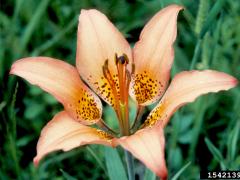 |
| Dave Powell, USDA Forest Service, bugwood.org | Joy Viola, Northeastern University, bugwood.org |
Lilium catesbaei, pine lily – Images at invasive.org
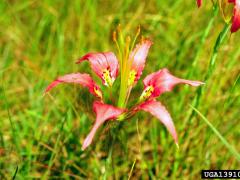 |
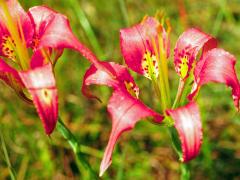 |
| John D. Byrd, Mississippi State University, bugwood.org | John D. Byrd, Mississippi State University, bugwood.org |
Additional Images for Orange Daylily
Orange daylily – Images at Invasive.org
Additional Information, Biology, Control and Management Resources
Control and management recommendations vary according to individual circumstances. Location, habitat, weather, and a variety of other conditions are factors that help determine the best treatment choice. To find the safest and most effective treatment for your situation, consult your state’s land-grant institution. If you will use chemicals as part of the control process, always refer to the product label.
United States Land-Grant University System – Find your land-grant university’s college of agriculture, Cooperative Extension office, or other related partner on this map provided by USDA.
Fact Sheet – Pennsylvania Dept. of Conservation and Natural Resources
Plant Invaders of Mid-Atlantic Natural Areas – National Park Service and U.S. Fish and Wildlife Service
Alien Plant Invaders of the Mid-Atlantic – National Park Service
Invasive species fact sheet – Morris Arboretum of the University of Pennsylvania
Robert W. Freckmann Herbarium – University of Wisconsin – Stevens Point
